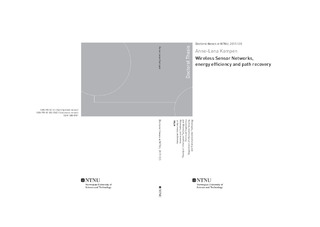| dc.contributor.advisor | Kure, Øivind | |
| dc.contributor.author | Kampen, Anne-Lena | |
| dc.date.accessioned | 2017-05-30T11:21:04Z | |
| dc.date.available | 2017-05-30T11:21:04Z | |
| dc.date.issued | 2017 | |
| dc.identifier.isbn | 978-82-326-2343-3 | |
| dc.identifier.issn | 1503-8181 | |
| dc.identifier.uri | http://hdl.handle.net/11250/2443835 | |
| dc.description.abstract | Wireless Sensor Networks (WSN) consists of sensor nodes equipped with radios for
wireless communication. The overall goal of the sensor networks is to gather data. The
terminal point for the data is usually a specific node, called the sink. Nodes collaborate
to relay data when direct communication between source and sink is impossible.
One of the main issues in WSN is energy consumption. Depleted nodes cannot collect
data and the value of the accumulated data at the sink is therefore degraded. Since
nodes forward traffic towards the sink, a depleted node may lead to network
partitioning, thereby causing part of the network to be unavailable for the sink.
This study investigates the energy consumption related to the radio, and suggests
algorithms to reduce the consumption. During operation, the radios switch between
different states such as receiving, transmitting, idle and sleep. The amount of energy
consumed varies with the radio state. The investigation reveals that the energy
consumed to receive packets can have a substantial impact on the total consumption. In
order to reduce the energy consumed in receiving, a simple algorithm has been
developed that can function as an add-on to common communication protocols. The
algorithm enables nodes to enter the sleep state rather than receive traffic that is not
addressed to them.
The second topic addressed is the balance of energy consumption among the nodes.
Balancing the energy consumption is a means to achieve an even residual-energy level
among the nodes. The goal is to avoid early depletion of nodes, thereby preserving
network availability. A broad range of different balancing algorithms has been
presented in the literature and these have been classified, analyzed and compared. In
addition, new balancing algorithms have been suggested. The routing protocol for Low
Power and Lossy network (RPL) was used as the basis for assessment and
improvements have been suggested. The findings are that, by introducing a minor
change in the RPL algorithm, a significant balancing effect can be achieved. However,
the best balancing effect is achieved if nodes always transmit data toward the next-hop
node with the highest residual-energy level.
The third topic addressed is path recovery algorithms. Radio links may break or a node
may die, either due to faults or to the already mentioned energy depletion. Link and
node errors may lead to network partitioning. Such errors should be corrected in order
to restore network connectivity. Various path-recovery algorithms have been proposed
in this respect. This study analyses some suggested algorithms and suggests a few new
recovery algorithms. The path recovery algorithms are categorized as either global or
local. In global path recovery, the paths are generally recovered during periodic global
network updates. Thus, high path-restoration delay may result in networks where the
global updates are infrequently run. The local recovery algorithms, on the other hand,
are triggered by path breaks and have a local scope. Thus, the local algorithms result in
low delay and affect a limited number of nodes. By minimizing the number of affected
nodes, the energy consumed during the process is reduced. However, the study
findings show that the percentage of disconnected paths that are recovered is lower
when using energy-efficient local recovery algorithms than when using global recovery
algorithms. The possible trade-offs between local and global recovery are discussed. | nb_NO |
| dc.language.iso | eng | nb_NO |
| dc.publisher | NTNU | nb_NO |
| dc.relation.ispartofseries | Doctoral theses at NTNU;2017:135 | |
| dc.relation.haspart | Paper A: Kampen, Anne-Lena; Øvsthus, Knut; Landmark, Lars; Kure, Øivind. Energy Reduction in Wireless Sensor Networks by Switching Nodes to Sleep During Packet Forwarding. I: SENSORCOMM 2012 : The Sixth International Conference on Sensor Technologies and Applications. International Academy, Research and Industry Association (IARIA) 2012 | nb_NO |
| dc.relation.haspart | Paper B: Kampen, Anne-Lena; Øvsthus, Knut; Kure, Øivind. Reconnection strategies in WSN running RPL. I: 2014 IEEE 39th Conference on Local Computer Networks Workshops (LCN Workshops). IEEE Press 2014 ISBN 978-1-4799-3782-0. s. 602-609
http://dx.doi.org/10.1109/LCNW.2014.6927709
© 2014 EEE. Personal use of this material is permitted. Permission from IEEE must be obtained for all other uses, in any current or future media, including reprinting/republishing this material for advertising or promotional purposes, creating new collective works, for resale or redistribution to servers or lists, or reuse of any copyrighted component of this work in other works. | nb_NO |
| dc.relation.haspart | Paper C: Kampen, Anne-Lena; Øvsthus, Knut; Kure, Øivind. An Analysis of the Need for Dedicated Recovery Methods and Their Applicability in Wireless Sensor Networks Running the Routing Protocol for Low-Power and Lossy Networks. SENSORCOMM; 2014-11-16 | nb_NO |
| dc.relation.haspart | Paper D: Kampen, Anne-Lena; Øvsthus, Knut; Kure, Øivind. Energy balancing algorithms in Wireless Sensor Networks. I: Proceedings of the 2015 Federated Conference on Computer Science and Information Systems. IEEE conference proceedings 2015 ISBN 978-83-60810-66-8. s. 1223-1231
http://dx.doi.org/10.15439/2015F67
© 2015 IEEE. Personal use of this material is permitted. Permission from IEEE must be obtained for all other uses, in any current or future media, including reprinting/republishing this material for advertising or promotional purposes, creating new collective works, for resale or redistribution to servers or lists, or reuse of any copyrighted component of this work in other works. | nb_NO |
| dc.relation.haspart | Paper E: Øvsthus, Knut; Nilsen, Espen; Kampen, Anne-Lena; Kure, Øivind. Modelling the Optimal Link Length in Wireless Sensor Networks for Two Different Media Access Protocols. Sensors & Transducers Journal 2015 ;Volum 185.(2) s. 21-28
Open access license: CC-BY-NC | nb_NO |
| dc.title | Wireless Sensor Networks, energy efficiency and path recovery | nb_NO |
| dc.type | Doctoral thesis | nb_NO |
| dc.subject.nsi | VDP::Technology: 500::Information and communication technology: 550::Telecommunication: 552 | nb_NO |
